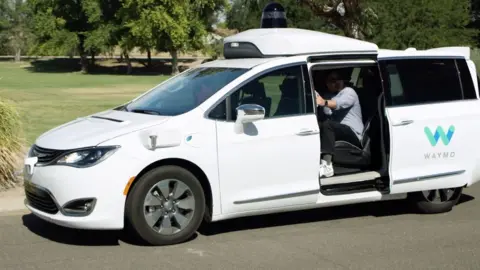No safety driver in Waymo's self-driving car taxi fleet
Self-driving car company Waymo has said it is confident enough in its technology to ditch the human safety driver and open up its fleet to the public.
Companies testing autonomous cars typically have a human on hand ready to step in if the car malfunctions.
But Waymo, owned by Google parent company Alphabet, said it no longer needed that protection - though at first one of its employees will ride in the back with customers.
The service will be made available in Phoenix, Arizona over the next few months, Waymo’s chief executive John Krafcik said.
It is the not the first time Waymo has demonstrated cars without human drivers - even as a back-up - on public roads.
Its driverless prototype has been tested over short journeys on pre-defined routes, including taking a blind man to a doctor’s appointment.
 Waymo
WaymoBut this latest move will greatly increase the ambition, and risk, of Waymo’s technology - it will eventually cover an area the size of Greater London, the company said.
'Shared mobility'
Members of the public will be riding in Fiat Chrysler Pacifica minivans. Initially a Waymo employee will travel with the customers, but not behind the wheel as has been the case previously. Eventually the public will be allowed to travel alone.
The self-driving taxi fleet will at first be free to use, but the company envisions it will charge for the journeys at a later date.
Waymo is a company created out of Google’s self-driving programme, and was seen as a way to step up efforts to commercialise the firm’s industry-leading efforts in autonomy.
To date, Waymo has conducted 3.5m miles on US public roads in a variety of scenarios. But unlike other companies working this kind of technology, such as Tesla, Waymo's products have not had a commercial application, and therefore, were making no money back on what has been an almost-decade-long, expensive investment.
“Because we see so much potential in shared mobility, the first way people will get to experience Waymo’s fully self-driving technology will be as a driverless service,” Mr Krafcik said told an audience at Web Summit, a technology conference being held in Lisbon this week.
Over time it is expected that self-driving technology could dramatically improve the safety on our roads. But experts have said the public should not expect this problem to be solved quickly.
Instances of people being killed in accidents involving self-driving cars will likely increase, argued Nidhi Kalra, co-author on a new study looking at self-driving safety.
But her report said that should not be a reason to delay adoption.
“Waiting for highly autonomous vehicles that are many times safer than human drivers misses opportunities to save lives,” the report concluded.
"It is the very definition of allowing perfect to be the enemy of good.”
Follow Dave Lee on Twitter @DaveLeeBBC
You can reach Dave securely through encrypted messaging app Signal on: +1 (628) 400-7370
